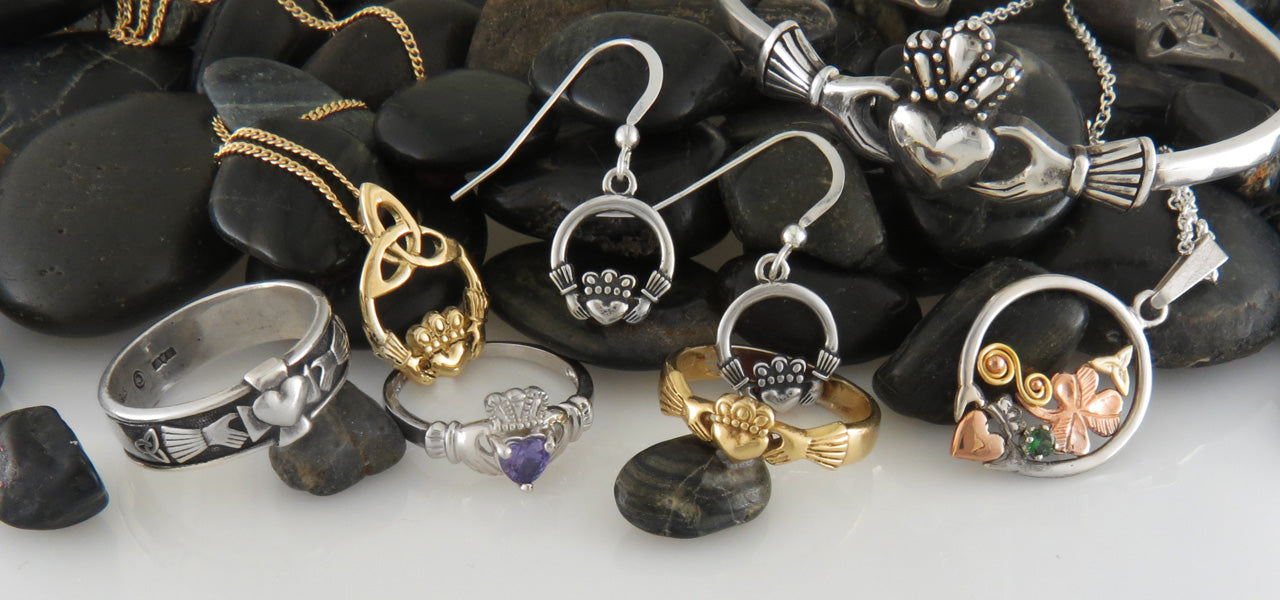- Jewelry
- Crosses
- Rings
- Mens
- Claddagh
- Wedding
- Personalized Jewelry
- John Urban Jewelry
- Sale
- Gift Certificates
- About Us

Claddagh Rings were very commonly used in the area around Galway since the late 17th century. The Claddagh is a fishing village on the outskirts of Galway City. It was a local fashion, which although it began to get wider notice in the early 20th century, was never really a part of the Celtic Revival. Towards the end of the 20th century there was an explosion of interest in the Claddagh Ring, both as jewelry and as an icon of Irishness that now adorns many other objects from pub signs to grave stones. In more recent years it has been embellished with interlace designs and combined with other Celtic and Irish symbols, but this is a very recent phenomenon that corresponds with the worldwide expansion in popularity of the Claddagh ring as an emblem of Irish identity
$95.00
Simulated Birthstone set in Sterling Silver Claddagh Ring. All months are available in sizes 5...
$65.00
The Heritage Claddagh Ring in Sterling Silver is designed to have all of the small...
$1,250.00
The Heritage Claddagh ring Walker Metalsmiths Celtic jewelry is set with a stunning 6mm heart shaped...
$950.00
Gold Claddagh Ring available in 14K Yellow, Rose or White Gold. In Irish tradition the...
$65.00
This Sterling Silver Claddagh Band is available in three widths. The design is based on...
$65.00
Sterling Silver Claddagh Ring. In Irish tradition, the heart symbolizes love, the crown symbolizes loyalty,...
$1,350.00
Unique original design based on the traditional Irish Claddagh ring, In Irish tradition, the heart...
$85.00
This Claddagh Cross Ring features a traditional claddagh heart and hands with a celtic cross...
$1,800.00
The Rounded Claddagh Ring in gold is available in 14K Yellow, Rose or White Gold. In...
$2,280.00
Our 14K White Gold Heritage Claddagh ring set with a stunning 6mm heart shaped Moissanite....
$1,875.00
Gold Claddagh Ring. Available in 14K Yellow, Rose or White Gold. In Irish tradition, the heart...
$85.00
Sterling Silver Claddagh Ring.In Irish tradition, the heart symbolizes love, the crown symbolizes loyalty, and...
$850.00
Gold Claddagh Ring. Available in 14K Yellow, Rose or White Gold. In Irish tradition, the...
$65.00
Sterling Silver Claddagh Ring.In Irish tradition, the heart symbolizes love, the crown symbolizes loyalty, and...
$1,100.00
Gold Claddagh Band. The traditional claddagh design has been elegantly set into a smooth edged band....
$2,650.00
Two piece ring set in 14K White Gold that represents an abstract claddagh ring. One...
$2,650.00
Two piece ring set in 14K White Gold that represents an abstract Claddagh ring. One...
$750.00
Celtic heritage Claddagh ring available in 14K Yellow, Rose, and White gold. The heart, hands and...
Sold Out
Two piece ring set in 14K White and Yellow Gold. One ring is set with...
$85.00
Silver Claddagh Ring. Available in select sizes In Irish tradition, the heart symbolizes love, the crown symbolizes loyalty,...
$6.00
Metals eventually tarnish when exposed to air (a natural reaction to sulfur in the air),...